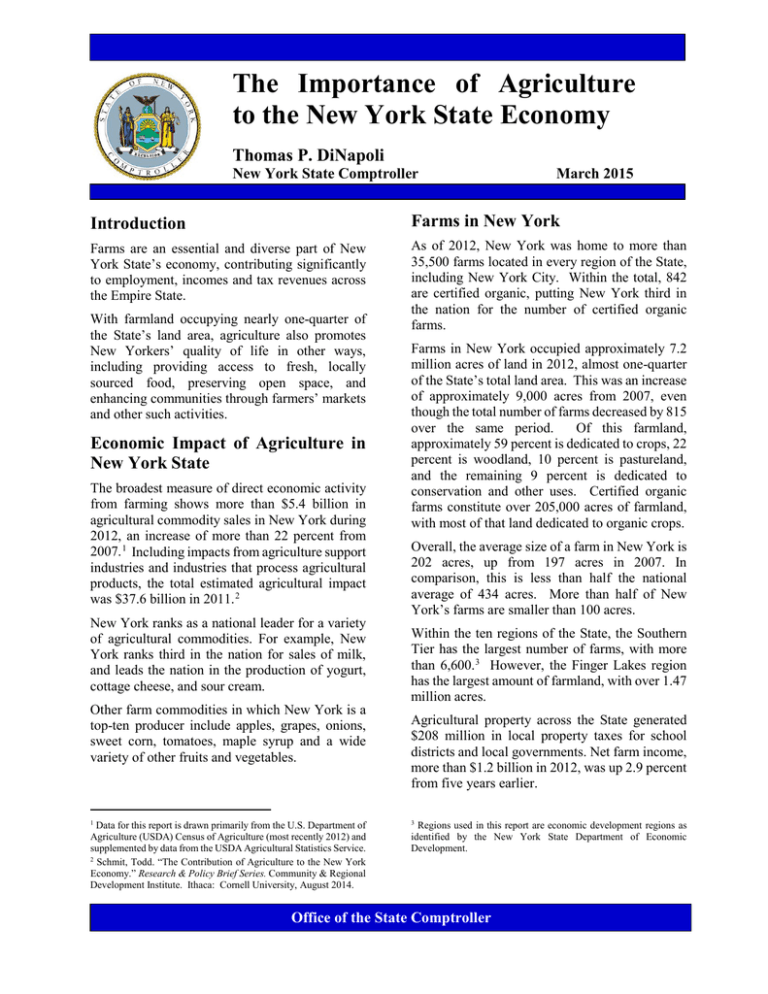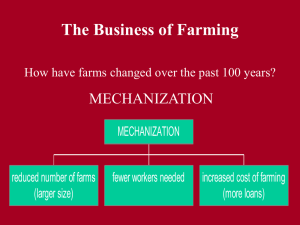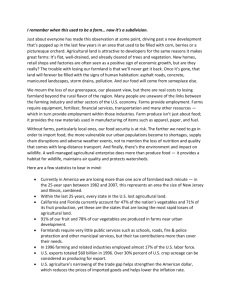Farms in New York Introduction
advertisement

The Importance of Agriculture to the New York State Economy Thomas P. DiNapoli New York State Comptroller March 2015 Introduction Farms in New York Farms are an essential and diverse part of New York State’s economy, contributing significantly to employment, incomes and tax revenues across the Empire State. As of 2012, New York was home to more than 35,500 farms located in every region of the State, including New York City. Within the total, 842 are certified organic, putting New York third in the nation for the number of certified organic farms. With farmland occupying nearly one-quarter of the State’s land area, agriculture also promotes New Yorkers’ quality of life in other ways, including providing access to fresh, locally sourced food, preserving open space, and enhancing communities through farmers’ markets and other such activities. Economic Impact of Agriculture in New York State The broadest measure of direct economic activity from farming shows more than $5.4 billion in agricultural commodity sales in New York during 2012, an increase of more than 22 percent from 2007. 1 Including impacts from agriculture support industries and industries that process agricultural products, the total estimated agricultural impact was $37.6 billion in 2011. 2 New York ranks as a national leader for a variety of agricultural commodities. For example, New York ranks third in the nation for sales of milk, and leads the nation in the production of yogurt, cottage cheese, and sour cream. Other farm commodities in which New York is a top-ten producer include apples, grapes, onions, sweet corn, tomatoes, maple syrup and a wide variety of other fruits and vegetables. 1 Data for this report is drawn primarily from the U.S. Department of Agriculture (USDA) Census of Agriculture (most recently 2012) and supplemented by data from the USDA Agricultural Statistics Service. 2 Schmit, Todd. “The Contribution of Agriculture to the New York Economy.” Research & Policy Brief Series. Community & Regional Development Institute. Ithaca: Cornell University, August 2014. Farms in New York occupied approximately 7.2 million acres of land in 2012, almost one-quarter of the State’s total land area. This was an increase of approximately 9,000 acres from 2007, even though the total number of farms decreased by 815 over the same period. Of this farmland, approximately 59 percent is dedicated to crops, 22 percent is woodland, 10 percent is pastureland, and the remaining 9 percent is dedicated to conservation and other uses. Certified organic farms constitute over 205,000 acres of farmland, with most of that land dedicated to organic crops. Overall, the average size of a farm in New York is 202 acres, up from 197 acres in 2007. In comparison, this is less than half the national average of 434 acres. More than half of New York’s farms are smaller than 100 acres. Within the ten regions of the State, the Southern Tier has the largest number of farms, with more than 6,600. 3 However, the Finger Lakes region has the largest amount of farmland, with over 1.47 million acres. Agricultural property across the State generated $208 million in local property taxes for school districts and local governments. Net farm income, more than $1.2 billion in 2012, was up 2.9 percent from five years earlier. 3 Regions used in this report are economic development regions as identified by the New York State Department of Economic Development. Office of the State Comptroller Farmers in New York During 2012, almost 56,000 New Yorkers were farm operators and nearly 61,000 other individuals were employed as hired farm labor during the year. Ninety eight percent of New York’s farms are family-owned. Where owners are married couples, both spouses tend to be involved with the daily operations. Most farmers in the State also live on their farms. Farming tends to be a long-term occupation with relatively little turnover compared to many other occupations. Over three-quarters of farmers have been farming for ten or more years, either operating their own farm or working on another’s. Slightly more than half of all farmers are primarily engaged in the occupation of farming (spending 50 percent or more of their worktime farming), with 43 percent having farming as their sole occupation. Along with the declining number of farms in New York, the number of farmers has also fallen since 2007. The ranks of hired farm workers increased slightly during the period, however. From a demographic perspective, farmers are an aging population with an average age in New York of 55. More than three-quarters of farmers in the State are over the age of 45. Both figures are close to national averages. While farming’s overall economic impact is important, the majority of farmers do not generate significant revenue from farm income. In 2012, slightly more than 50 percent of New York farms had sales of less than $10,000. Major Agricultural Products Though New York ranks 26th among the 50 states for total value of agricultural sales, it ranks in the top ten for a number of agricultural commodities. New York ranks in the top five for milk production, and for horses, ponies, mules, and donkeys. It also ranks in the top ten for fruits, tree nuts and certain berries, as well as floriculture and nursery products. Cows’ milk is by far the largest agricultural commodity in New York, with sales topping $2.4 billion, representing more than 44 percent of the State’s total sales in 2012. The State’s other top commodities include: grains, dry peas and beans, Office of the State Comptroller cattle and calves, and vegetables, melons, and potatoes (see Figure 1). In addition, New York is a leading producer of specific agricultural products encompassed within these broad commodity categories. New York ranks second nationwide in apple production, third for grapes and fourth for pears. Figure 1 Top Agricultural Commodities in New York Sales (millions) Milk from Cows Grains, Oilseeds, Dry Beans, Dry Peas Cattle and Calves Nursery, Greenhouse, Floriculture, Sod Vegetables, Melons, and Potatoes Fruits, Tree Nuts, and Berries Other Crops and Hay Poultry and Eggs Horses, Ponies, Mules, and Donkeys Hogs and Pigs Other Animals/Other Animal Products Sheep, Goats, Wool, Mohair and Milk Aquaculture Christmas Trees and Woody Crops Total $2,417 $856 $450 $413 $364 $308 $301 $145 $58 $39 $20 $19 $18 $7 $5,415 Share of U.S. Total Rank 44.6% 3 15.8% 27 8.3% 30 7.6% 9 6.7% 13 5.7% 6 5.6% 18 2.7% 29 1.1% 5 0.7% 29 0.4% 21 0.4% 13 0.3% 20 0.1% 8 26 Source: U.S. Department of Agriculture, 2012 Census of Agriculture New York is one of the top ten producers nationwide of cherries, peaches, strawberries and for many types of vegetables, including cabbage, cauliflower, cucumbers, onions, pumpkins, beans, squash, sweet corn, and tomatoes. Besides the agricultural commodities themselves, New York is a leader in the production of goods made from these commodities. A good example is New York’s wine industry. New York is the second largest producer of wine behind California. In 2013, New York had 373 wineries and produced over 33.5 million gallons of wine, according to the Alcohol and Tobacco Tax and Trade Bureau. In addition, New York wines have consistently won top honors at national and international wine competitions. New York is also the nation’s second largest producer of maple syrup behind Vermont, and leads the nation in a variety of dairy products. It ranks first in the nation for the production of yogurt, cottage cheese, and sour cream, and fourth for the production of all cheeses. Page | 2 Regional Profiles Central New York Agricultural production occurs in every part of the State, even in New York City. The top five counties for sales in 2012 were Wyoming, Cayuga, Suffolk, Genesee, and St. Lawrence counties (see Figure 2). The Central New York region includes Cayuga, Cortland, Madison, Onondaga, and Oswego Counties. The region has more than 3,500 farms and 785,000 acres of farmland and ranks third in the State for agricultural sales, while Cayuga County alone ranks second in the State (See Figure 3). The region is also the number one producer of soybeans and a top producer of corn. Other top commodities include Christmas trees and woody crops, as well as sheep and goats. Figure 2 Agricultural Sales by County in 2012 Figure 3 Top Ten New York Farming Counties Sources: U.S. Department of Agriculture; Office of the State Comptroller Finger Lakes The Finger Lakes region includes the counties of Genesee, Livingston, Monroe, Ontario, Orleans, Seneca, Wayne, Wyoming, and Yates. This region is the center of New York agriculture, having the largest amount of farmland in the State. It also ranks first in total amount of farm sales. As an official wine region of the State recognized by the federal Tax and Trade Bureau, the Finger Lakes region contains 113 wineries, the most of any region, and has been named the Wine Enthusiast’s top wine destination of 2015. In addition, the region ranks first for milk, grains and dry beans. North Country The North Country region includes Clinton, Essex, Franklin, Hamilton, Jefferson, Lewis, and St. Lawrence Counties. The region ranks second in the State for total agricultural sales and third in farm acreage. Along with the Finger Lakes region, the North Country is one of the top producers of milk and dairy products as well as cattle and calves, and is the top producer for hay and grass silage for feed. Office of the State Comptroller Total Sales Number (thousands) of Farms Wyoming $ 318,412 713 Cayuga 289,235 891 Suffolk 239,818 604 Genesee 234,292 549 St. Lawrence 186,431 1,303 Livingston 185,477 661 Wayne 181,511 873 Ontario 178,980 853 1,667 Steuben 177,710 876 Jefferson 177,025 8,990 Total - Top Ten $ 2,168,891 $ 5,471,639 35,537 Total - State Source: U.S. Department of Agriculture, 2012 Census of Agriculture Western New York Western New York includes the counties of Allegany, Cattaraugus, Chautauqua, Erie, and Niagara. The region comprises over 5,100 farms and 870,000 acres of farmland. Home to the Lake Erie wine region, Western New York has 44 wineries. Chautauqua County and Allegany County are New York’s top producers of grapes, and of hogs and pigs, respectively. Southern Tier The Southern Tier comprises Broome, Chemung, Chenango, Delaware, Otsego, Schuyler, Steuben, Tioga, and Tompkins counties. This region has the State’s largest number of farms and ranks fifth in total agricultural sales. The region’s top commodities include hay, hogs and pigs, and oats. Capital District The Capital District includes Albany, Columbia, Greene, Rensselaer, Saratoga, Schenectady, Warren, and Washington counties. The region comprises almost 3,500 farms and 587,000 acres of farmland. The Capital District is one of the top Page | 3 producers of short rotation woody crops, such as those used by the paper or pulp industry, as well as apples. Saratoga County ranks third in the State for the sales of horses, ponies, and sod. Long Island The Long Island region, including Nassau and Suffolk counties, has 659 farms and approximately 39,000 acres of farmland, most of it in Suffolk County. The region is ranked first in the State for aquaculture as well as for nursery stock crops and sod. Suffolk County ranks third in the State for overall agricultural sales, and is another official wine region, with 90 wineries. With its large winery presence, it ranks third in the State for grape production. Hudson Valley The Hudson Valley region includes Dutchess, Orange, Putnam, Rockland, Sullivan, Ulster, and Westchester counties. The region has approximately 2,400 farms and 340,000 acres of farmland. Similar to Long Island, the region has a strong focus on the wine industry, with 52 wineries. In addition, the region ranks first in the State for horses, ponies and donkeys. Mohawk Valley The Mohawk Valley includes Fulton, Herkimer, Montgomery, Oneida, and Schoharie counties. The region has 3,100 farms and 607,000 acres of farmland. The region has a large inventory of bee colonies and goats. New York City New York City is home to 31 farms, located in all boroughs except Manhattan. Most of these farms are less than 10 acres in size, and predominantly have sales of nursery stock and floriculture. Agricultural Policy Initiatives In recognition of the importance of farming in the State’s economy and quality of life, a variety of policy initiatives, including tax incentives, have been created to promote stability and growth in New York's agricultural sector. Measures intended to ease the tax burden on New York's farmers include provisions affecting personal income, sales, property and corporate taxes. Other programs assist in maintaining lands in farm use. Office of the State Comptroller For example, the Farmland Protection Program provides grants to municipalities to pay for 50 percent of the costs of creating a farmland protection plan. Once a plan is in place, the program can pay for 75 percent of the purchase costs of conservation easements on farmland from willing farmers. In addition, to address the aging population of farmers, the State has created the New Farmers Grant Fund to encourage young people to take up the farming profession. This fund breaks down some of the cost barriers to those entering the farming profession by providing grants to finance equipment purchases, farming supplies, or the construction or expansion of farm buildings. By creating opportunities for New York’s consumers to purchase locally-sourced food, the State can amplify the benefits of farming by circulating more dollars spent on food in the State within its farming communities and expanding access to healthy, nutritious foods. Programs to promote local New York farms include: • The FreshConnect program, which supports bringing fresh food from New York farms to communities without ready access to food stores selling fresh, nutritious foods. • The Fresh Fruit and Vegetable Program, which provides funding to schools to purchase, prepare and serve fresh fruits and vegetables. • The Food Metrics Law, which encourages State agencies to purchase food produced by New York’s farmers and requires reporting on the amounts of local food purchased. Conclusion Agriculture in New York is diverse and makes significant contributions to the economy all across the State. While primarily engaging small, family businesses, farming’s overall impact is in the billions of dollars each year. The payoff in quality of life also includes environmental benefits, such as preservation of open space. For economic, social and other reasons, a strong farming sector is critical to the Empire State. As farmers continue to address the challenges driven by factors at the local, national and even international levels, close attention to the most effective mix of State policies to support agriculture will remain essential. Page | 4






